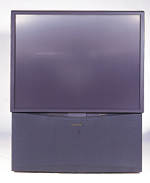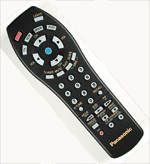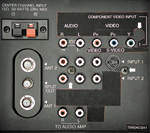Face Off: Big-Screen Smackdown Panasonic PT-51D30
Panasonic has been a major force in the push to bring HDTV to market. They were one of the first manufacturers to actually sell an HD-ready display, and their professional division has been sponsoring Monday Night Football in 720p. However, like everyone else, they still make analog televisions. They graciously accepted our challenge to participate in this Face Off and sent their PT-51D30.
 The set comes equipped with four audio/video inputs, one on the front and three on the back. While all of them include composite video jacks, the second input on back has a y/c connection, and the third is dedicated to your DVD player's component output. A pair of audio connections allow the TV's sound to be sent to your external surround processor. A unique feature to the Panasonic display, among those in the Face Off, is the inclusion of speaker-terminal inputs, which allow you to connect the center channel's speaker-level output from your external surround receiver. Center-channel sound can then be piped into the TV's main speakers. This may not be the best long-term solution, but it offers an upgrade path in a pinch.
The set comes equipped with four audio/video inputs, one on the front and three on the back. While all of them include composite video jacks, the second input on back has a y/c connection, and the third is dedicated to your DVD player's component output. A pair of audio connections allow the TV's sound to be sent to your external surround processor. A unique feature to the Panasonic display, among those in the Face Off, is the inclusion of speaker-terminal inputs, which allow you to connect the center channel's speaker-level output from your external surround receiver. Center-channel sound can then be piped into the TV's main speakers. This may not be the best long-term solution, but it offers an upgrade path in a pinch.
Just like WWF characters, the user menu is quite creative. Press the action button on the remote, and what Clint described as a slot-machine-type display appears. As you press the up and down arrows, the menu "roller" spins, exposing another menu item. This system is easy to use and, more importantly, makes setting up the TV a snap. The graphics are a bit clunky, but they get out of the way when you make adjustments. Chris ranked the menu second-best of the group.
 Panasonic's remote also rates well. The relatively small, backlit unit can control three other devices, in addition to the television. Clint liked the translucent buttons, even though only the channel-up/-down, action, and source buttons illuminate. Nearly everyone found the remote easy to use, although I thought the consistent button color made the layout less intuitive. Overall, though, I ranked the PT-51D30's remote as the best in the bunch.
Panasonic's remote also rates well. The relatively small, backlit unit can control three other devices, in addition to the television. Clint liked the translucent buttons, even though only the channel-up/-down, action, and source buttons illuminate. Nearly everyone found the remote easy to use, although I thought the consistent button color made the layout less intuitive. Overall, though, I ranked the PT-51D30's remote as the best in the bunch.
Panasonic's display continues to excel by using an accurate color decoder, thus offering the opportunity for brighter yet natural-looking colors. Panasonic's comb filter, however, is equal to the one used in Hitachi's display. Although the effects may be subtle, look closely and you can see the dot crawl between color borders and will most likely notice the rainbow moiré in fine checkerboardlike details. Even less subtle of an effect is the floating black level. The PT-51D30 does an OK job of keeping black levels stable. Dark scenes do get a bit brighter, while brighter scenes have deeper blacks. Unfortunately, none of us were too keen on the display's ultimate black level. Even the deepest, darkest of black images never got truly dark.
 Another dichotomy was the Panasonic TV's perceived detail level. When viewing test patterns, each of the judges agreed that the Panasonic clearly had greater fine detail than any display in the test. However, with regular video, particularly when fine text was involved, the image had a slight halo or flare to it that softened the picture. Clint had mixed feelings about the effect, commenting that it seemed to smooth together the otherwise wickedly apparent line structure that makes up the picture on NTSC TVs but that it also made the picture a hair soft.
Another dichotomy was the Panasonic TV's perceived detail level. When viewing test patterns, each of the judges agreed that the Panasonic clearly had greater fine detail than any display in the test. However, with regular video, particularly when fine text was involved, the image had a slight halo or flare to it that softened the picture. Clint had mixed feelings about the effect, commenting that it seemed to smooth together the otherwise wickedly apparent line structure that makes up the picture on NTSC TVs but that it also made the picture a hair soft.
The PT-51D30 performed reasonably well in the overall test, partly (I'd guess) because its gray-scale setting is fairly blue. Bluer images tend to have more snap and appear brighter, even though actual light output may be identical. The downside to this is a loss in color saturation and fidelity. The picture loses some of the snap it should have with its accurate color decoder. Unfortunately, we weren't able to obtain proper information to recalibrate the set during the course of the review. We hope to do so in the future and will provide a follow-up.
In the end, Panasonic scored well in several categories. They offer a good set of features and an excellent remote. The only drawbacks are a slight softness in an otherwise exceptionally detailed image and blacks that don't get totally black. Sure, the onscreen graphics are a bit goofy, but they're effective and unobtrusive. The picture, with its accurate color decoder, looks reasonably natural and vibrant. Given its wide range of attributes, Panasonic's TV is likely to appeal to those whose needs match the set's particular strengths and weaknesses.
• Backlit remote
• Accurate color decoder

HT Labs Measures: Panasonic PT-51D30
The chart above shows the gray scale (or color temperature) of the Panasonic TV and the color points of the display's red, green, and blue phosphors. The gray scale measures bluish (at 7,500 Kelvin) with darker images and even more blue (10,500 K) with brighter images. We were unable at the time of the test to make adjustments to the image and will keep you updated in a future issue if that situation changes. The Panasonic's red and blue color points are excellent, matching those specified by SMPTE. The green CRT, however, is slightly yellow. The light output was approximately 34 foot-lamberts, with a 100-IRE white window that filled 15% of the image and remained consistent with full-field images. The display has an accurate color decoder and displays at least 470 horizontal lines (per picture height) with the Video Essentials DVD played on a Sony DVD player.—MW































































